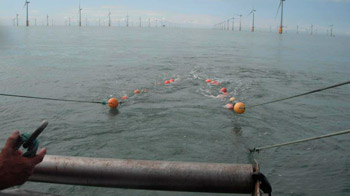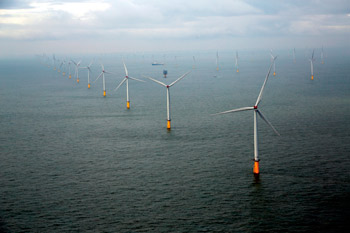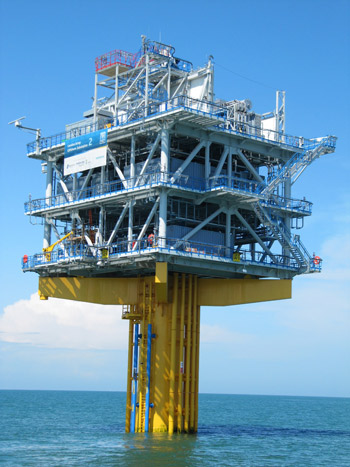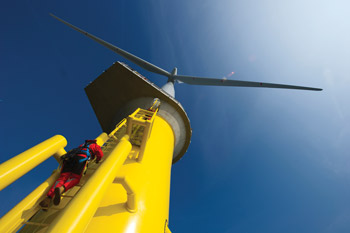Offshore Wind Energy UK and US
by Fishermen's Voice Staff

Shooting otter trawl in Thanet Wind Farm, southeast of Kent. The Thanet site is smaller then the London Array. London Array Limited photo
The development of wind energy in the Gulf of Maine was reviewed at the NEFMC April meeting in Mystic, CT. A scheduled 15-minute Northeast Regional Planning Board presentation led to some of the more exclamatory comments that day. Council members were concerned with offshore wind energy development in New England as it relates to fish habitat.
New data on the pace and scale of the project led to discussions of what the council needs to do to get up to speed on assessing its role in engaging with the process for the fishing industry.

Section of the London Array off the east coast of Kent, England. Ship in the distance. Power terminal tower midway between rows of turbines, fishing boat to the right of terminal tower. London Array Limited photo
David Preble is on the habitat committee of the NEFMC. He said recent technological developments in wind energy have set the stage for a much more rapid development of a large area of the northeast coastline. What has been thought of as something that was ten years in the future, Preble said, was ready to be put in place now. The difference has been new more powerful French wind turbines. That immediacy has caught managers and stakeholders of guard. With little or no baseline data to work from Preble said it was important to get organized quickly to engage with the wind development process. Each turbine installation will require bottom excavation for the base and the buried concrete anchors.

Transmitter on foundation. Power terminal and base. The London Array has two of the terminals. London Array Limited photo
The French strides forward in turbine technology have resulted in a more attractive prospect for investors and investor money is fueling the increasing pace of wind energy development. Europe Preble said, is far ahead of the U.S. in developing wind energy projects. The French company Alstom has been selling 6 megawatt turbines, twice the size of turbines previously planned for U.S. turbine fields, as fast as they can make them to countries around the world. This 6 MW turbine will ”be the game changer in U.S. investment in wind energy”, said Preble.
Noting research in the northeast U.S., Preble said, scientists have identified an offshore region between Virginia and Maine where it could be possible to continuously take advantage of optimum velocity winds. Winds traveling east across the U.S. reach the Atlantic coast and the cold air over the water sends the wind currents north along the coast. A series of large of turbine fields along the coast, interconnected with cables, will be able to take advantage of maximum winds at changing north-south locations.

Service barge installing wind turbine blades. Adjustable pilings stabilize barge during installation of turbines and blades. London Array Limited photo
Preble was in Europe recently where he surveyed wind energy installations and said he was amazed at the number of turbines in the water in several countries. France, he said currently gets 80% of its electricity from nuclear power and the rest from wind and solar.
John Williamson, a former fishery management council member and currently a consultant in marine planning for the Ocean Conservancy, organized a trip for six fishermen and fishery managers in 2013 to research wind energy development off the coasts of England. There they visited an offshore wind farm and spoke with English fishermen about their experience interacting with the energy industry and government in the construction of turbine fields in their North Sea fishing grounds. He also arranged for four English fishermen to visit the U.S. to discuss their experience with New England fishermen.

Service personnel climbing wind turbine base. The London Array. London Array Limited photo
Williamson said fishermen need to be involved in having areas identified for fishing and protect their interests. “Offshore wind power permitting will require extensive Environmental Impact Statements (EIS) which BOEM will analyze. In the end, BOEM will follow its own criteria in deciding what to permit and where, and what qualifications to require,” said Williamson. He said offshore wind energy technology in the United Kingdom is developing quickly, expanding into deep water environments, “If it goes to similar scale here, then the seascape in the future will be very different than it is today”. Williamson suggested that there are major implications for fisheries in this and that there should be clearer avenues for fishermen to get involved in shaping and providing guidance at the very beginning of development. “What we need is comprehensive planning, with everyone who has a stake in the outcome at the table,” he said.

The last foundation to receive a tower and turbine. The London Array. London Array Limited photo
Council member and Ecosystem Based Management committee member Dr. Michael Sissenwine, referred to the rapidly developing plans to install a large number of wind turbines in the Gulf of Maine as “a runaway train”. Sissenwine also said the effect on essential fish habitat from the installation of wind turbines could be as big as any event in the near future on essential fish habitat (EFH).
Because there have been so many technical breakthroughs in wind energy technology Sissenwine said there is a need to have workshops on these developments to broaden the understanding of the current situation among management and stakeholders.

Power cable coming ashore at Cleve Hill, Kent. Mouth of the Thames River.
Ellen Goethel worked on the baseline studies for the Seabrook New Hampshire nuclear power plant’s Environmental Impact Statement (EIS). Goethel, a NEFMC member and New Hampshire resident, followed Sissenwine’s comments by noting the Seabrook EIS was a study that lasted 10 years before construction began. She said the wind energy companies are not being held to the same standards. “Because people think it’s green the wind energy projects are getting a green flag to go, go, go”, said Goethel. She said she is not opposed to wind energy development, but said that there is no plan or funding for an EIS or for decommissioning these wind generators. Since the privately owned turbines have a life span the cost of removing them could become the responsibility of the tax payers without a decommissioning plan.
Preble said the effect on the ocean bottom would come from digging to embed concrete block anchors, trenching for the network of cables, matressing- the granite rubble over bottom cables to protect them, and down stream scouring –the silt cloud that is deposited over the bottom down stream of the excavation.
Sissenwine said, all of the bottom is habitat for something and therefore its inevitable that disruption of the bottom will be in essential habitat for some species. “It therefore gives the NEFMC the right and the expectation, within the Magnuson Stevens Act, that there will be comment on the impact on essential fish habitat” by this project, he said.
See more photos and related items at Fishermen's Voice E-Edition Extras Section.
